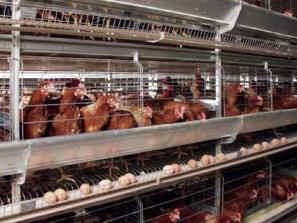Yeast metabolites have positive impact on layer performance

Maintaining a healthy flock is a key component to egg production and quality. Based on recent research, the nutritional metabolites in Diamond V’s yeast metabolites are optimising the health and performance of white and brown strain layers.
The nutritional metabolites of yeast formulated in Original XPC are the result of a distinctive bio-fermentation process. The proprietary anaerobic fermentation process yields a biologically complex, nutrient-diverse product that contains the extra-cellular metabolites of fermentation, residual Saccharomyces cerevisiae cells and the media utilised during fermentation. The final result is an exclusive product containing many beneficial nutritional metabolites. The key bioactive components include the specific nutritional metabolites, proteins, peptides, amino acids, vitamins, minerals, antioxidants, beta-glucans and mannans. The effectiveness of these components is not compromised by extreme temperature or processing.
Gut health and immune system
Improving the general health of the animal by balancing the immune system, reducing the pathogen load in the gut, and increasing nutrient absorption will allow for improved production. In young laying hens, the initiation of lay can be very stressful for the bird. Improving nutrient passage via a healthy gut will improve the chance for better initial and continued egg production. An efficient immune system will provide increased protection against pathogens at the site of infection, preventing the need of a systemic immune response. When the immune response becomes systemic, nutrients are repartitioned away from egg production to support the immune system.The combination of nutritional metabolites in the yeast derived product improves bird health by balancing the immune system while improving gut health and nutrient digestibility. The interrelation between nutrition and the immune system is important for both fighting off pathogen invasion and allowing for optimal growth. An ideal immune system would have negligible nutrient ‘costs’, rapid expansion and efficient elimination of pathogens, cause no collateral damage (of healthy tissue), and no reduction in animal performance.
In vivo and in vitro research conducted with Diamond V fermentation metabolite products have shown positive effects on immune cells that destroy pathogens, such as macrophages and natural killer cells, while reducing proinflammatory cytokines and reactive oxygen species which can damage healthy cells. Metabolites and bioactive factors secreted from probiotic bacteria and Saccharomyces cerevisiae have been previously shown to reduce the production of proinflammatory cytokines.
Along with immune balance, Diamond V metabolites have been proven to shift the microbial population by reducing ‘bad’ bacteria and improving beneficial bacteria. In addition to improved bacterial diversity in the gut, research with the yeast metabolites have shown beneficial effects on intestinal morphology. Increases in villus height and density, as well as villus height to crypt depth ratio, will improve digestion and nutrient absorption.
North Carolina ‘random sample’ test
The monitoring of the productivity of the diverse strains of laying hens available through-out the United States (and also the world) has been important to the state of North Carolina. Started more than 50 years ago, studies have been regularly conducted on multiple strains of laying hens at the Piedmont Research Center. The tests were initiated to provide the producers in North Carolina current productivity results on the strain of laying hen they may be using compared to other strains available.
The Piedmont Research Station is one of North Carolina’s oldest research stations and conducts research in poultry, dairy, field crops and horticultural crops. The station has the capacity to evaluate the effects of a research project on a size and scale of a commercial poultry operation. It contains housing for more than 15,000 commercial layers, 8,000 broiler breeders, and incubation capacity to hatch more than 52,000 eggs at one time utilising both multi-stage and single-stage incubation. More than 100 years old, the station may be best known for the layer performance and management tests it has conducted since 1958.Originally known as the North Carolina Random Sample Poultry Test, because one case of eggs was selected by random from each of the participating hatcheries, is now known as North Carolina Layer Performance and Management Test. The first test, completed in 1959, involved 20 different sources of chicks from around the United States and measured production parameters up to 150 days post-hatch. Only six parameters were initially compared such as mortality, feed intake, body weight, and feed and chick cost and average eggs per pullet at 150 days. Today, not only are they comparing production parameters, but can measure egg size, grade, and several other quality parameters through moult and the second laying cycle.
The project leader of these tests has been a faculty member from North Carolina State University. Dr. Ken Anderson is the third project leader and is responsible for the current, ongoing, 38thNorth Carolina Layer Performance and Management Test. This extensive poultry research trial involves over 9,500 laying hens from a total of 18 strains: 11 different white and 7 different brown strains tested at two different stocking densities. Apart from the regular parameters compared in the current test, Original XPC was included as a variable.
Better productivity
The production, egg size and quality results from the first 16-weeks (four, 4-week cycles) of egg production comparing feeding with and without 0.75 kg/tonne XPC was presented at the International Poultry Scientific Forum last January in Atlanta, Georgia. The study was conducted during the summer of 2010 between May and August, when heat stress can occur. Egg production, feed intake, feed conversion, and mortality were monitored through-out the 16 weeks. Egg weight and USDA grade and size were measured on all eggs from a 24 hour laying period, once during the 2nd, 3rd and 4thfour-week cycles. The results were statistically analysed separately for white and brown strains to determine the effects of XPC addition to the diet.
Conclusions
The statistical improvements from the inclusion of XPC in the diet were observed in multiple parameters in both white and brown strains and can be seen in Table 1. The most notable effect of feeding the yeast metabolites was on increased hen-day egg production (Figure 1).
Upon grading of the eggs (USDA quality parameters) increased grade A quality (Figure 2) and reduced check and leaker eggs were found from hens fed the yeast product and during USDA egg size grading more extra large eggs and subsequently fewer medium eggs (Figures 3 and 4) were observed.
These results show that feeding XPC can help improve production and egg quality parameters when the hens are under stressors of early egg production. The 11 strains of white hens and 7 strains of brown hens included in this test represent almost all layer strains used in commercial production today and yeast metabolites improved overall egg production. The increased hen-day production coincides with the numerous layer field studies conducted with XPC.
References are available on request.
Join 26,000+ subscribers
Subscribe to our newsletter to stay updated about all the need-to-know content in the feed sector, three times a week. Beheer
Beheer









 WP Admin
WP Admin  Bewerk bericht
Bewerk bericht